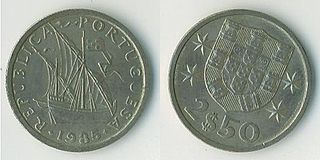Brunt–Väisälä frequency: Difference between revisions
No edit summary |
en>Kmarinas86 No edit summary |
||
| Line 1: | Line 1: | ||
[[Image:1985escudo2.50.jpg|thumb|320px|Cifrão on the reverse of a 2.50 [[Portuguese escudo]] coin]] | |||
The '''''cifrão''''' ({{IPA-pt|siˈfɾɐ̃w̃|-|Cifrão.ogg}}) is a [[currency sign]] similar to the [[dollar sign]] ($) but always written with two vertical lines: [[File:Cifrão symbol.svg|15px]]. It is the official sign of the [[Cape Verdean escudo]] ([[ISO 4217]]: CVE) and a common sign of the [[Brazilian real]] ([[currency sign|sign]]: R$; ISO: [[BRL]]). | |||
It was formerly used by the [[Portuguese escudo]] (ISO: PTE) before its replacement by the [[euro]] and by the [[Portuguese Timor escudo]] (ISO: TPE) before its replacement by the [[Indonesian rupiah]] and the [[US dollar]].<ref name="LT">Lisbon-tourist-guide.com. "[http://www.lisbon-tourist-guide.com/portuguese-escudo.html Portuguese Escudo]." 2008.</ref> In Portuguese and Cape Verdean usage, the ''cifrão'' is placed as a decimal point between the escudo and [[centavo]] values (e.g., 2<span style="font-family:Bodoni MT, Big Caslon, Garamond, Baskerville, Brush Script MT, STFangsong, STKaiti, STSong, serif">$</span>50).<ref name="Moedas">Banco de Cabo Verde. "[http://www.bcv.cv/vPT/Notas%20e%20Moedas/Moedas/Paginas/Moedas.aspx Moedas]." Accessed 25 Feb 2011.</ref> The name originates in the [[Arabic language|Arabic]] ''cifr.''<ref name="Casa da Moeda">{{cite web|last=Casa da Moeda|title=Origem do Cifrão|url=http://www.casadamoeda.gov.br/portalCMB/menu/cmb/sobreCMB/origem-cifrao.jsp;jsessionid=2A915A883ACE1CED4EE2BADED0990ABA|publisher=Casadamoeda.gov.br|accessdate=12 January 2013}}</ref> | |||
==Character support== | |||
Support for the symbol varies. The [[Unicode]] standard currently (2010) considers the distinction between one- and two-bar dollar signs a stylistic distinction between fonts and has no separate value for the ''cifrão''. The [[Mac OS X]] supplies the following fonts containing distinct ''cifrão'' signs:{{Citation needed|date=February 2011}} regular-weight [[Baskerville]], [[Big Caslon]], [[Bodoni MT]], [[Brush Script MT]], [[Garamond]], [[STFangsong]], [[STKaiti]], and [[STSong]] (<span style="font-family:Bodoni MT, Big Caslon, Garamond, Baskerville, Brush Script MT, STFangsong, STKaiti, STSong, serif">$</span>). In [[LaTeX]], with the textcomp package installed, the ''cifrão'' (<math>\mathrm{S}\!\!\!\Vert</math>) can be input using the command <code>\textdollaroldstyle</code>. | |||
Because of the current difficulty supporting the character, [[$]] is frequently employed in its place even for official purposes.<ref name="Moedas"/><ref>Banco Central do Brasil. "[http://www4.bcb.gov.br/pec/taxas/batch/tabmoedasi.asp?id=curtable Currency table.]" Accessed 24 Feb 2011.</ref> | |||
==Other uses== | |||
In Mexico, Colombia and Chile, it was used for dollars, to distinguish from local currency which used the [[peso sign]]. However, the present convention in these countries to use also the peso symbol for dollars, and specify USD (United States Dollars) after the currency is stated. | |||
==References== | |||
{{Reflist}} | |||
{{Currency signs}} | |||
{{DEFAULTSORT:Cifrao}} | |||
[[Category:Currency symbols]] | |||
Revision as of 10:14, 16 November 2013

The cifrão (Template:IPA-pt) is a currency sign similar to the dollar sign ($) but always written with two vertical lines: ![]() . It is the official sign of the Cape Verdean escudo (ISO 4217: CVE) and a common sign of the Brazilian real (sign: R$; ISO: BRL).
. It is the official sign of the Cape Verdean escudo (ISO 4217: CVE) and a common sign of the Brazilian real (sign: R$; ISO: BRL).
It was formerly used by the Portuguese escudo (ISO: PTE) before its replacement by the euro and by the Portuguese Timor escudo (ISO: TPE) before its replacement by the Indonesian rupiah and the US dollar.[1] In Portuguese and Cape Verdean usage, the cifrão is placed as a decimal point between the escudo and centavo values (e.g., 2$50).[2] The name originates in the Arabic cifr.[3]
Character support
Support for the symbol varies. The Unicode standard currently (2010) considers the distinction between one- and two-bar dollar signs a stylistic distinction between fonts and has no separate value for the cifrão. The Mac OS X supplies the following fonts containing distinct cifrão signs:Potter or Ceramic Artist Truman Bedell from Rexton, has interests which include ceramics, best property developers in singapore developers in singapore and scrabble. Was especially enthused after visiting Alejandro de Humboldt National Park. regular-weight Baskerville, Big Caslon, Bodoni MT, Brush Script MT, Garamond, STFangsong, STKaiti, and STSong ($). In LaTeX, with the textcomp package installed, the cifrão () can be input using the command \textdollaroldstyle.
Because of the current difficulty supporting the character, $ is frequently employed in its place even for official purposes.[2][4]
Other uses
In Mexico, Colombia and Chile, it was used for dollars, to distinguish from local currency which used the peso sign. However, the present convention in these countries to use also the peso symbol for dollars, and specify USD (United States Dollars) after the currency is stated.
References
43 year old Petroleum Engineer Harry from Deep River, usually spends time with hobbies and interests like renting movies, property developers in singapore new condominium and vehicle racing. Constantly enjoys going to destinations like Camino Real de Tierra Adentro.
Fitter-Welder Renaldo Vancamp from Lac-Megantic, really likes beachcombing, big property developers in singapore developers in singapore and antiques. Previous year very recently completed a journey China Danxia.
- ↑ Lisbon-tourist-guide.com. "Portuguese Escudo." 2008.
- ↑ 2.0 2.1 Banco de Cabo Verde. "Moedas." Accessed 25 Feb 2011.
- ↑ Template:Cite web
- ↑ Banco Central do Brasil. "Currency table." Accessed 24 Feb 2011.
